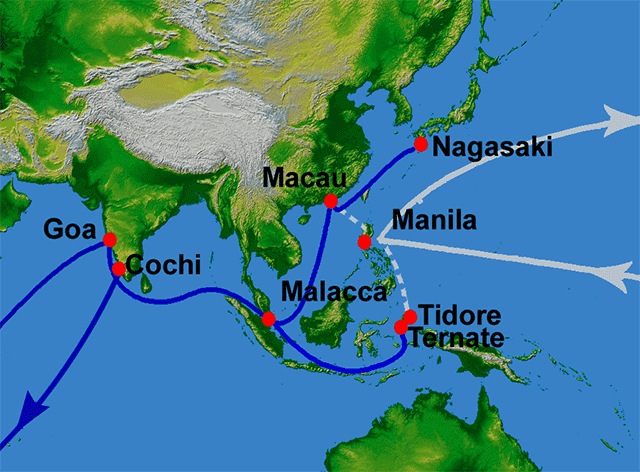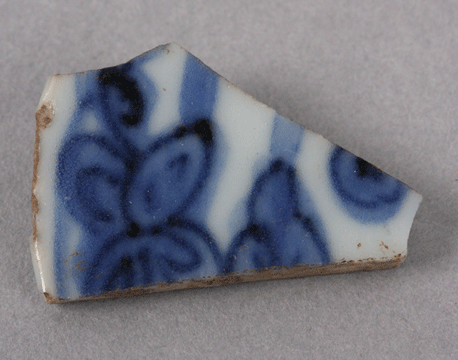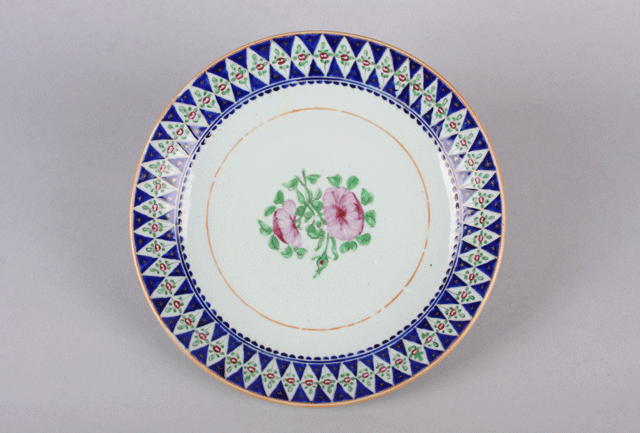
Early sea routes linking China to the world ... including New Mexico!

Early sea routes linking China to the world ...
including New Mexico!
The concept of the "modern world" is very Eurocentric; it refers to the rise of European nation-states and their use of ocean-going ships to take control of international trade. When this process began, about 1500, China had been a successful civilization for many centuries. Still, something did change for China: it became tied to the emerging world economy. That process is still unfolding today.
The process began in the early 1500s, when Portuguese ships arrived off the Chinese coast. In 1557 the Portuguese settled in Macao (Macau), creating the first effective economic link between China and the outside world. The Spanish soon followed and Manila, in the Philippine Islands, became a center of European power in the east. The new sea routes and towns fed the global demand for Chinese goods, which included silk cloth and porcelain. In particular, blue-and-white porcelain made at Jingdezhen was valued everywhere in the West. Between the late 1500s and the late 1700s, the Chinese made vast quantities of blue-and-white porcelain and exported most of it. reference
The Portuguese sea routes extended from China and southeast Asia to India,
around the south end of Africa, and up the west side of Africa to Europe. In
contrast, the Spanish shipped Asian goods to their empire via a single route
across the Pacific. The "Manila Galleon" carried Chinese and other goods to
Mexico, and some of those goods were then shipped from Mexico to Spain. The
reach of this trade is shown by the tiny fragment of Chinese porcelain shown
below.

68.43.64, fragment of Chinese porcelain,
1 inch (23 mm) long. Photo by B. Bernard.
The blue-and-white fragment shown above is one of several bits of Chinese porcelain found at San Gabriel de Yunque, the first Spanish capital of New Mexico. The original piece reached San Gabriel between 1598 and 1610. Similar fragments of Chinese pottery have been found by archaeologists in many parts of Spanish colonial New Mexico. reference A special section of this online exhibit explores Chinese porcelain in Spanish Colonial New Mexico. The presence of Chinese porcelain in such a remote corner of the Spanish empire shows how strong the demand for Chinese goods had become four hundred years ago.
The Chinese made the most of the world craze for Chinese porcelain. In the
early 1700s they reorganized their porcelain production to create goods
designed for Western markets. You can learn about that export industry
by clicking on the thumbnail below.

Chinese export pottery (click on the
image to enter)
While the West demanded Chinese goods, China had little use for Western goods. This imbalance of trade led to the steady flow of wealth—mostly in the form of silver—from the West to China. The trade imbalance problem was "solved" by the British, who were on their way to dominatng the world's sea lanes. By the late 1700s the British had a monopoly on opium (then produced in India) and saw an addicted Chinese population as the key to creating Chinese demand for an outside commodity. When the Chinese government attempted to suppress the opium trade, war broke out. The Chinese were unable to overcome European military technology and Britain was able to impose the opium trade on China. This was the beginning of a series of trade concessions wrung out of China by Western powers and Japan, at the point of a gun.
Trade concessions came with territorial concessions, as outside powers established themselves along the Chinese coast. The process culminated in the Japanese seizure of Manchuria and, later, large sections of the Chinese coast. In China, the period between 1839 and 1949 is sometimes referred to as the "century of humiliation" due to China's inability to hold its own against foreign powers. Nonetheless, the China continued to be a major exporter of goods, including porcelain. It took a series of catastrophes—the civil strife of the 1920s and 1930s, the Japanese invasion and World War II, and the Chinese Revolution—to push China back into economic isolation. Today we tend to think of the flood of Chinese goods in the world market as a recent development, but it's nothing new. Instead, Chinese goods have been in world demand since the early 1500s, and their disappearance during the middle and late 1900s was a temporary side effect of social and military turmoil.
Today, there are two Chinese nation-states: the People's Republic of China, on the mainland, and the Republic of China, on the island of Taiwan. The museum does not want to take sides in internecine disputes, but we will close our section on China's modern period with two observations. First, this is not the first time that China has consisted of more than one state. Much of the 900s were referred to as the Ten Kingdoms period, for example. Second, even when China was unified it was not just a nation. Instead it is a civilization. Indeed, it is the longest-surviving civilization on the planet.
See source code for copyright information. Page last revised on March 4, 2015. Please report problems to toh@unm.edu